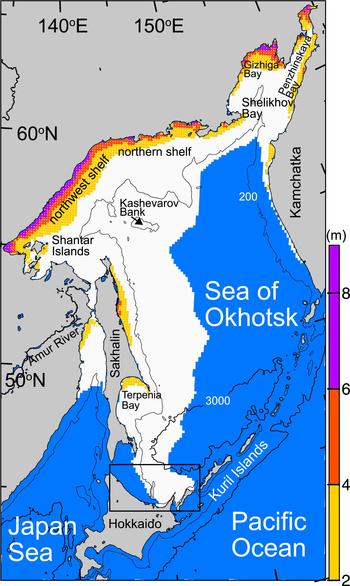At this point in the Arctic refreezing phase, LIFO inventory accounting comes into play. Last-In, First-out is one accepted way to price the value of a company’s inventory. For Arctic ice, it means that basins that are last to freeze over in winter are the first to melt out in the summer. For example, in Mid January 2021, total NH ice extent is 91% of last March maximum, so most basins have long been covered with ice. The last 9% will be added in four places (present % of max is noted):
Bering Sea 62%
Okhotsk Sea 70%
Barents Sea 58%
Baffin Bay 66%
In the Pacific animation above, Bering on the right adds ice extent from 261k km2 to 513k km2 since Jan. 1, while Okhotsk goes from 500k km2 to 800k km2. Together they will likely add ~650k km2 more by March maximum.
On the Atlantic side, Barents Sea added only ~100k km2 so far in January. More interesting on the right side is the Baltic Sea quadrupled from 9K km2 to 42k km2. While the Baltic extent is not large by comparison, it is already 38% greater than last March maximum, so that is surprising.
Normally, ice in the Yellow Sea is insignificant, but this year is different. Perhaps you saw reports like this one from gcaptain Sea Ice Slows Ships In North China Ports Excerpts in italics with my bolds.
By Muyu Xu and Chen Aizhu (Reuters) – Chinese ports and marine safety authorities are on high alert as an expansion of sea ice makes it tougher for ships to berth and discharge at key energy product import terminals along the coast of northern Bohai Bay.
A cold wave sweeping the northern hemisphere has plunged temperatures across China to their lowest in decades, boosting demand for power and fuel to historic highs in the world’s largest energy consumer.
Bohai Bay appears in the upper right corner, with Beijing nearby. Yellow Sea extent doubled in January up to 28,000 km2, which is twice the maximum last March.
Background on Okhotsk Sea
NASA describes Okhotsk as a Sea and Ice Factory. Excerpts in italics with my bolds.
The Sea of Okhotsk is what oceanographers call a marginal sea: a region of a larger ocean basin that is partly enclosed by islands and peninsulas hugging a continental coast. With the Kamchatka Peninsula, the Kuril Islands, and Sakhalin Island partly sheltering the sea from the Pacific Ocean, and with prevailing, frigid northwesterly winds blowing out from Siberia, the sea is a winter ice factory and a year-round cloud factory.
The region is the lowest latitude (45 degrees at the southern end) where sea ice regularly forms. Ice cover varies from 50 to 90 percent each winter depending on the weather. Ice often persists for nearly six months, typically from October to March. Aside from the cold winds from the Russian interior, the prodigious flow of fresh water from the Amur River freshens the sea, making the surface less saline and more likely to freeze than other seas and bays.

Map of the Sea of Okhotsk with bottom topography. The 200- and 3000-m isobars are indicated by thin and thick solid lines, respectively. A box denotes the enlarged portion in Figure 5. White shading indicates sea-ice area (ice concentration ⩾30%) in February averaged for 2003–11; blue shading indicates open ocean area. Ice concentration from AMSR-E is used. Color shadings indicate cumulative ice production in coastal polynyas during winter (December–March) averaged from the 2002/03 to 2009/10 seasons (modified from Nihashi and others, 2012, 2017). The amount is indicated by the bar scale. Source: Cambridge Core
Bering Sea Ice is Highly Variable
The animation above shows Bering Sea ice extents at April 2 from 2007 to 2020. The large fluctuation is evident, much ice in 2012 -13 and almost none in 2018, other years in between. Given the alarmist bias, it’s no surprise which two years are picked for comparison:

Source: Seattle Times ‘We’ve fallen off a cliff’: Scientists have never seen so little ice in the Bering Sea in spring.


Taking a boat trip from Hokkaido Island to see Okhotsk drift ice is a big tourist attraction, as seen in the short video below. Al Gore had them worried back then, but not now.

Drift ice in Okhotsk Sea at sunrise.




Reblogged this on Climate Collections.
LikeLiked by 1 person